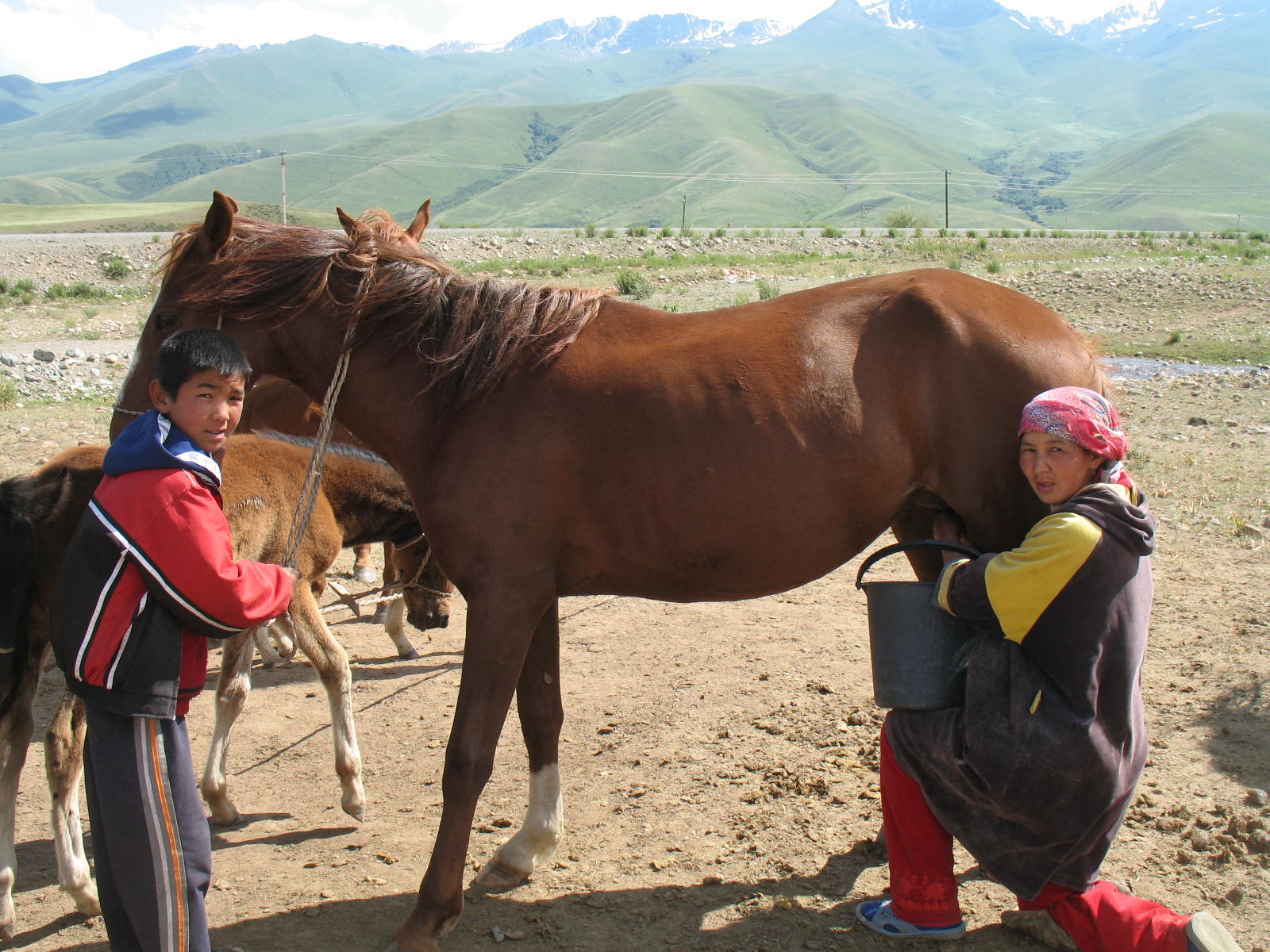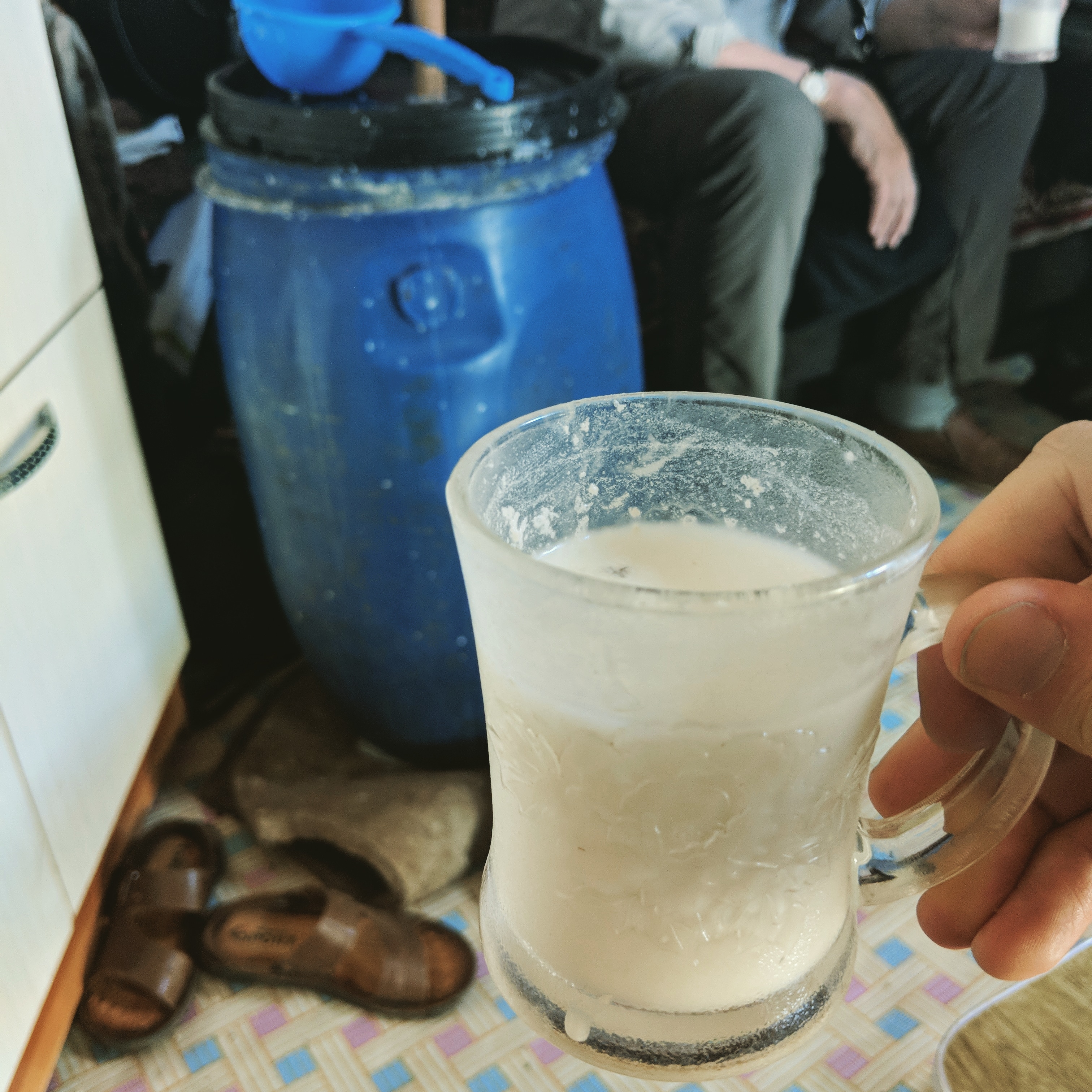|
Kumys
''Kumis'' (also spelled ''kumiss'' or ''koumiss'' or ''kumys'', see other transliterations and cognate words below under terminology and etymology – otk, airag kk, қымыз, ''qymyz'') mn, айраг, ''ääryg'') is a fermented dairy product traditionally made from mare milk or donkey milk. The drink remains important to the peoples of the Central Asian steppes, of Turkic and Mongol origin: Kazakhs, Bashkirs, Kalmyks, Kyrgyz, Mongols, and Yakuts. Kumis was historically consumed by the Khitans, Jurchens, Hungarians, and Han Chinese of North China as well. ''Kumis'' is a dairy product similar to ''kefir'', but is produced from a liquid starter culture, in contrast to the solid ''kefir'' "grains". Because mare's milk contains more sugars than cow's or goat's milk, when fermented, ''kumis'' has a higher, though still mild, alcohol content compared to ''kefir''. Even in the areas of the world where ''kumis'' is popular today, mare's milk remains a very limited commodity. ... [...More Info...] [...Related Items...] OR: [Wikipedia] [Google] [Baidu] |
Kumis
''Kumis'' (also spelled ''kumiss'' or ''koumiss'' or ''kumys'', see other transliterations and cognate words below under terminology and etymology – otk, airag kk, қымыз, ''qymyz'') mn, айраг, ''ääryg'') is a fermented dairy product traditionally made from mare milk or donkey milk. The drink remains important to the peoples of the Central Asian steppes, of Turkic and Mongol origin: Kazakhs, Bashkirs, Kalmyks, Kyrgyz, Mongols, and Yakuts. Kumis was historically consumed by the Khitans, Jurchens, Hungarians, and Han Chinese of North China as well. ''Kumis'' is a dairy product similar to ''kefir'', but is produced from a liquid starter culture, in contrast to the solid ''kefir'' "grains". Because mare's milk contains more sugars than cow's or goat's milk, when fermented, ''kumis'' has a higher, though still mild, alcohol content compared to ''kefir''. Even in the areas of the world where ''kumis'' is popular today, mare's milk remains a very limited commod ... [...More Info...] [...Related Items...] OR: [Wikipedia] [Google] [Baidu] |
Donkey Milk
Donkey milk (or ass milk, or jenny milk) is the milk from the domesticated donkey ''(Equus asinus)''. It has been used since antiquity for cosmetic purposes as well as infant nutrition. History Donkey milk has been used by humans for alimentary and cosmetic purposes since Egyptian antiquity; doctors recommended it to treat several afflictions, due to its healing and cosmetic virtues. Hippocrates (460 – 370 BC), was the first to write of the medicinal use of donkey milk and prescribed it for numerous conditions including poisoning, fevers, infectious diseases, edema, healing wounds, nose bleeds, and liver trouble.Hippocrates. The Genuine Work of Hippocrates. Vol. 1. Sydenham Society 1843 In the Roman era donkey milk was a recognized remedy; Pliny the Elder (23 – 79 AD) in his encyclopedic work, ''Naturalis Historia'', wrote extensively about its health benefits, i.e. to fight fever, fatigue, eye strain, weakened teeth, face wrinkles, poisonings, ulcerations, asthma and ce ... [...More Info...] [...Related Items...] OR: [Wikipedia] [Google] [Baidu] |
Mare Milk
Mare milk is milk lactated by female horses, known as mares, to feed their foals. It is rich in whey protein, polyunsaturated fatty acids and vitamin C, and is a key ingredient in kumis. In several European countries, including Germany, it is sold powdered. Mare milk is sometimes chosen over cow milk for its purported health benefits. A niche market considers it a remedy for skin or digestive problems. Peer-reviewed papers suggest it can reduce atopic dermatitis or eczema. It is used to make cosmetics and can form cheese with camel rennet, but not bovine. See also * Donkey milk * Goat milk * Moose milk Moose milk, also known as elk milk, refers to milk produced by moose (''Alces alces''). Though it is most commonly consumed by moose calves, its production has also been commercialised in Russia, Sweden and Canada. Nutritional content Moose mi ... References Milk by animal Female horses Horse products {{food-stub ... [...More Info...] [...Related Items...] OR: [Wikipedia] [Google] [Baidu] |
Han Chinese
The Han Chinese () or Han people (), are an East Asian ethnic group native to China. They constitute the world's largest ethnic group, making up about 18% of the global population and consisting of various subgroups speaking distinctive varieties of the Chinese language. The estimated 1.4 billion Han Chinese people, worldwide, are primarily concentrated in the People's Republic of China (including Mainland China, Hong Kong and Macau) where they make up about 92% of the total population. In the Republic of China (Taiwan), they make up about 97% of the population. People of Han Chinese descent also make up around 75% of the total population of Singapore. Originating from Northern China, the Han Chinese trace their cultural ancestry to the Huaxia, the confederation of agricultural tribes living along the Yellow River. This collective Neolithic confederation included agricultural tribes Hua and Xia, hence the name. They settled along the Central Plains around the middle and lo ... [...More Info...] [...Related Items...] OR: [Wikipedia] [Google] [Baidu] |
Transliterated
Transliteration is a type of conversion of a text from one script to another that involves swapping letters (thus '' trans-'' + '' liter-'') in predictable ways, such as Greek → , Cyrillic → , Greek → the digraph , Armenian → or Latin → . For instance, for the Modern Greek term "", which is usually translated as " Hellenic Republic", the usual transliteration to Latin script is , and the name for Russia in Cyrillic script, "", is usually transliterated as . Transliteration is not primarily concerned with representing the sounds of the original but rather with representing the characters, ideally accurately and unambiguously. Thus, in the Greek above example, is transliterated though it is pronounced , is transliterated though pronounced , and is transliterated , though it is pronounced (exactly like ) and is not long. Transcription, conversely, seeks to capture sound rather than spelling; "" corresponds to in the International Phonetic Alphabet. While ... [...More Info...] [...Related Items...] OR: [Wikipedia] [Google] [Baidu] |
Turkic Languages
The Turkic languages are a language family of over 35 documented languages, spoken by the Turkic peoples of Eurasia from Eastern Europe and Southern Europe to Central Asia, East Asia, North Asia (Siberia), and Western Asia. The Turkic languages originated in a region of East Asia spanning from Mongolia to Northwest China, where Proto-Turkic is thought to have been spoken, from where they expanded to Central Asia and farther west during the first millennium. They are characterized as a dialect continuum. Turkic languages are spoken by some 200 million people. The Turkic language with the greatest number of speakers is Turkish language, Turkish, spoken mainly in Anatolia and the Balkans; its native speakers account for about 38% of all Turkic speakers. Characteristic features such as vowel harmony, agglutination, subject-object-verb order, and lack of grammatical gender, are almost universal within the Turkic family. There is a high degree of mutual intelligibility, upon mode ... [...More Info...] [...Related Items...] OR: [Wikipedia] [Google] [Baidu] |
Whey
Whey is the liquid remaining after milk has been curdled and strained. It is a byproduct of the manufacturing of cheese or casein and has several commercial uses. Sweet whey is a byproduct resulting from the manufacture of rennet types of hard cheese, like cheddar or Swiss cheese. Acid whey (also known as sour whey) is a byproduct brought out during the making of acid types of dairy products, such as strained yogurt. Whey proteins consist of α-lactalbumin, β-lactoglobulin, serum albumin, immunoglobulins, and proteose peptones. Composition Whey protein is the collection of globular proteins isolated from whey. The protein in cow's milk is 20% whey protein and 80% casein protein, whereas the protein in human milk is 60% whey and 40% casein. The protein fraction in whey constitutes approximately 10% of the total dry solids in whey. This protein is typically a mixture of beta-lactoglobulin (~48-58%), alpha-lactalbumin (~13-19%), bovine serum albumin (~6%)(see also serum albumi ... [...More Info...] [...Related Items...] OR: [Wikipedia] [Google] [Baidu] |
Sucrose
Sucrose, a disaccharide, is a sugar composed of glucose and fructose subunits. It is produced naturally in plants and is the main constituent of white sugar. It has the molecular formula . For human consumption, sucrose is extracted and refined from either sugarcane or sugar beet. Sugar mills – typically located in tropical regions near where sugarcane is grown – crush the cane and produce raw sugar which is shipped to other factories for refining into pure sucrose. Sugar beet factories are located in temperate climates where the beet is grown, and process the beets directly into refined sugar. The sugar-refining process involves washing the raw sugar crystals before dissolving them into a sugar syrup which is filtered and then passed over carbon to remove any residual colour. The sugar syrup is then concentrated by boiling under a vacuum and crystallized as the final purification process to produce crystals of pure sucrose that are clear, odorless, and sweet. Suga ... [...More Info...] [...Related Items...] OR: [Wikipedia] [Google] [Baidu] |
Fermentation (food)
In food processing, fermentation is the conversion of carbohydrates to alcohol or organic acids using microorganisms—yeasts or bacteria—under anaerobic (oxygen-free) conditions. Fermentation usually implies that the action of microorganisms is desired. The science of fermentation is known as zymology or zymurgy. The term "fermentation" sometimes refers specifically to the chemical conversion of sugars into ethanol, producing alcoholic drinks such as wine, beer, and cider. However, similar processes take place in the leavening of bread (CO2 produced by yeast activity), and in the preservation of sour foods with the production of lactic acid, such as in sauerkraut and yogurt. Other widely consumed fermented foods include vinegar, olives, and cheese. More localised foods prepared by fermentation may also be based on beans, grain, vegetables, fruit, honey, dairy products, and fish. History and prehistory Natural fermentation precedes human history. Since ancient times, h ... [...More Info...] [...Related Items...] OR: [Wikipedia] [Google] [Baidu] |
Lactose
Lactose is a disaccharide sugar synthesized by galactose and glucose subunits and has the molecular formula C12H22O11. Lactose makes up around 2–8% of milk (by mass). The name comes from ' (gen. '), the Latin word for milk, plus the suffix '' -ose'' used to name sugars. The compound is a white, water-soluble, non-hygroscopic solid with a mildly sweet taste. It is used in the food industry. Structure and reactions Lactose is a disaccharide derived from the condensation of galactose and glucose, which form a β-1→4 glycosidic linkage. Its systematic name is β-D-galactopyranosyl-(1→4)-D-glucose. The glucose can be in either the α-pyranose form or the β-pyranose form, whereas the galactose can only have the β-pyranose form: hence α-lactose and β-lactose refer to the anomeric form of the glucopyranose ring alone. Detection reactions for lactose are the Woehlk- and Fearon's test. Both can be easily used in school experiments to visualise the different lactose content o ... [...More Info...] [...Related Items...] OR: [Wikipedia] [Google] [Baidu] |
Protein
Proteins are large biomolecules and macromolecules that comprise one or more long chains of amino acid residues. Proteins perform a vast array of functions within organisms, including catalysing metabolic reactions, DNA replication, responding to stimuli, providing structure to cells and organisms, and transporting molecules from one location to another. Proteins differ from one another primarily in their sequence of amino acids, which is dictated by the nucleotide sequence of their genes, and which usually results in protein folding into a specific 3D structure that determines its activity. A linear chain of amino acid residues is called a polypeptide. A protein contains at least one long polypeptide. Short polypeptides, containing less than 20–30 residues, are rarely considered to be proteins and are commonly called peptides. The individual amino acid residues are bonded together by peptide bonds and adjacent amino acid residues. The sequence of amino acid residue ... [...More Info...] [...Related Items...] OR: [Wikipedia] [Google] [Baidu] |







.jpg)

